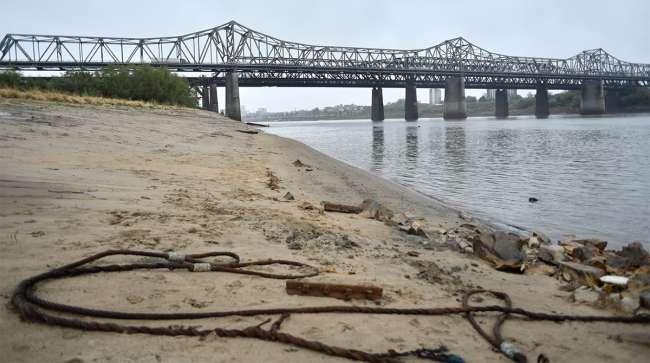Bloomberg News
Mississippi River Dries Up Again at Worst Time for Farmers

[Stay on top of transportation news: Get TTNews in your inbox.]
The Mississippi River is suffering from low waters for the third straight autumn, a crucial time of year when American farmers rely on the route to deliver their crops to the world.
Months of limited rainfall — with few chances for more during the rest of the season — have left the vital waterway so shallow that barges are starting to run aground, even after shippers started running lighter loads to prevent boats from hitting the river bottom.
While the situation isn’t as chaotic as in years past, the lack of water is again creating headaches for shippers and farmers. The drying of the Mississippi over the past three years is raising shipping costs and hindering farmers’ ability to compete for markets overseas. During the best of times, nearly two-thirds of U.S. crop exports are shipped on the Mississippi to the Gulf of Mexico.
“Longer periods of low water, and increased transportation costs to get bushels to port in the U.S., ultimately starve off business,” said No Bull Inc. grain analyst Susan Stroud.
Low Mississippi River water levels are still causing some grain shipping constraints. Last week, barge movements fell below year-ago levels for the first time since July. We need some serious rain for the Mississippi River System to get relief. pic.twitter.com/rsAFlD7taK — Dawson Schmitt (@schmitt_dawson) October 25, 2024
Shipping costs are currently about 55% above the average for the past five years. While demand for American soy and corn is strong, those elevated costs could create a competitive disadvantage once farmers in Brazil start harvesting early in 2025.
For now, because world buyers in countries like China are rushing to import U.S. crops ahead of the Nov. 5 presidential election, shippers are able to pass along the extra costs. U.S. corn at the Gulf of Mexico is priced at about $197 per metric ton — just below prices in the Brazilian port of Santos.
World demand has been shifting away from the U.S. for years, partly due to increased domestic processing that keeps more supplies in the country. The river problems are only making a recovery more difficult.
For the third year in a row, low water levels on the Mississippi River expose a path to Tower Rock. "When we have drought years like we're experiencing now on the Mississippi, we see things like this where the river exposes the bedrock." - Mike Sertle, Central Regional Director… — American Rivers (@americanrivers) October 25, 2024
“We are at the mercy of the river,” said Bryce Baker, general manager of the Jersey County Grain terminal in Hardin, Ill. Baker started booking barges he needed this month back in August to make sure he wasn’t short.
So-called draft restrictions, which limit how deep a vessel can sit in the water, mean a barge of corn could have 27% less than a full load. “It definitely affects the volume,” Baker said. “It’s really making facilities like mine get longer barge freight.”
The problem stems from a dry spell in the regions that feed the Mississippi as well as the Missouri and Ohio rivers. Across the Midwest, nearly 83% of the land is abnormally dry and almost 53% is in drought, according to the U.S. Drought Monitor.
Want more news? Listen to today's daily briefing above or go here for more info
It’s so dry that one good rain won’t solve the low water problems on the river, said Drew Smith, deputy chief of the watershed division of the Army Corps of Engineers.
Officials aren’t ready to blame climate change. The recent trend of dryness was preceded by a lengthy wet period that didn’t end until 2020. “It’s very cyclical, we see it both ways,” Smith said.
“It remains to be seen what may be driving the dryness over the last few years,” said Trent Ford, the Illinois State Climatologist, a position under the University of Illinois. “Three years doesn’t make a trend.”




